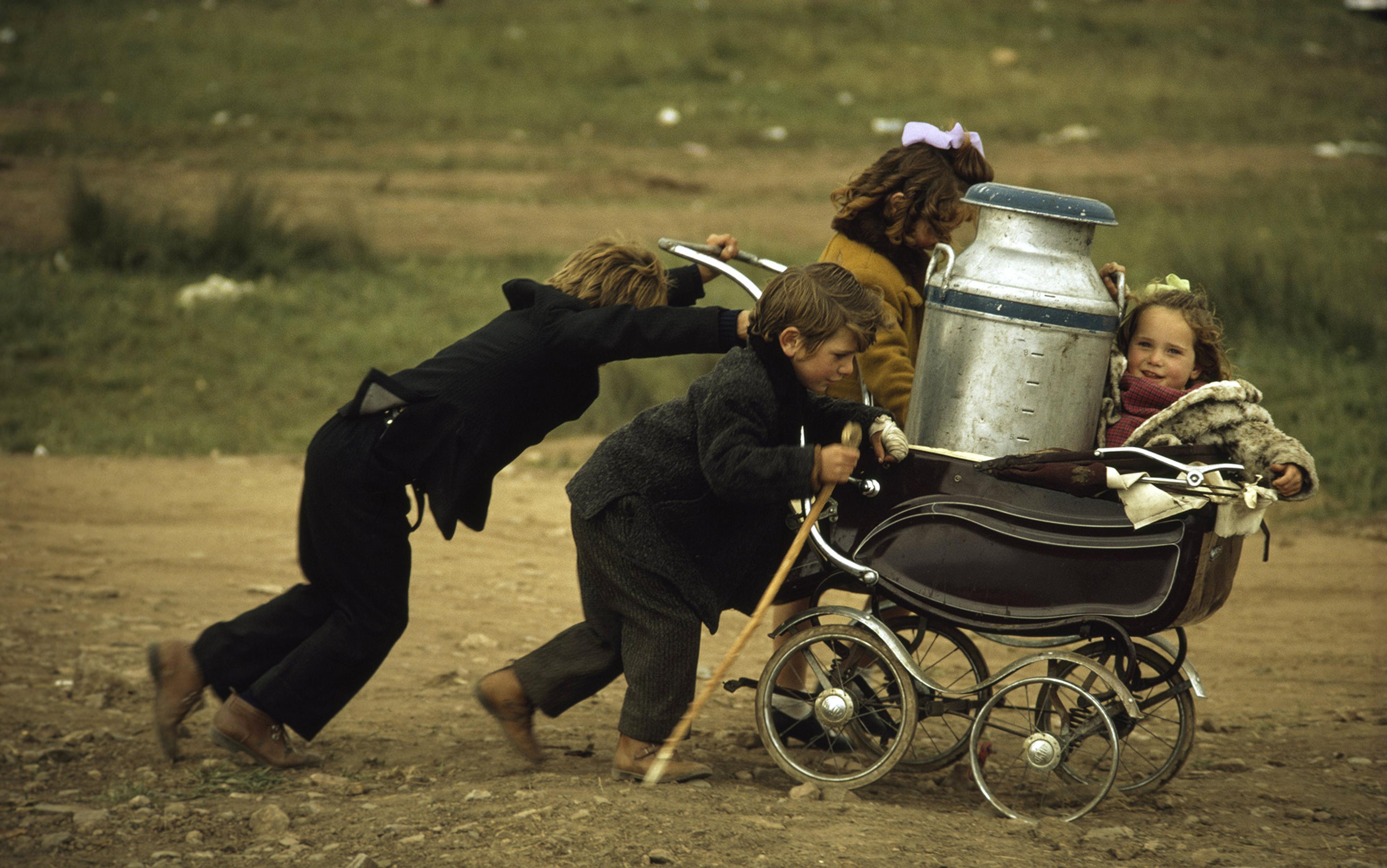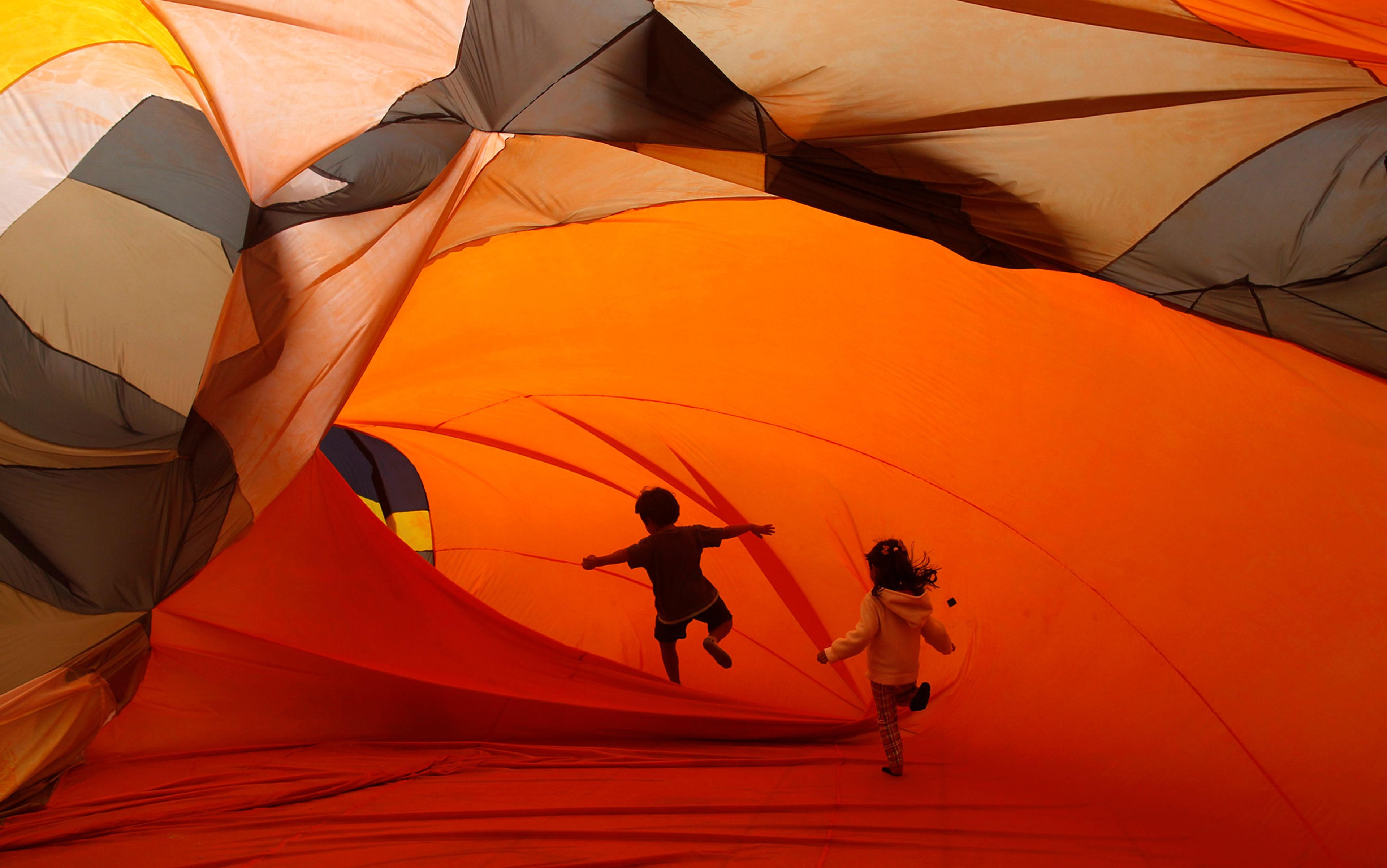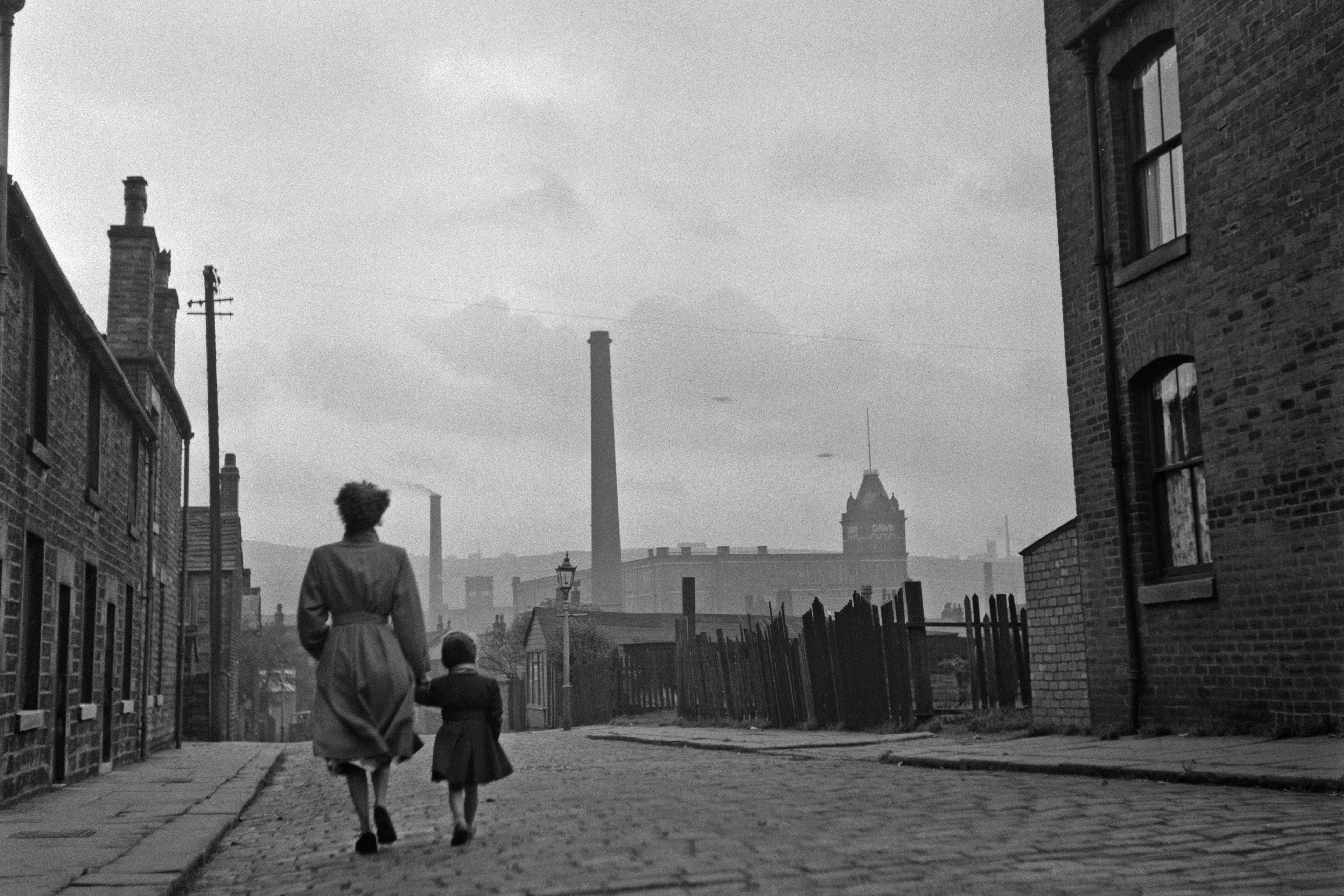Imata raun paiga? (‘What is she doing?’) – my husband’s grandmother, Digna, asks him. The ‘she’ Digna is referring to is me. What I am doing is rather simple: I am wrapping my four-month-old son in a baby sling, his face toward my chest, in a calm, reassuring embrace. But my husband’s grandmother, who has raised 12 children in a small village in the Ecuadorian Amazon, does not think of this mundane gesture as being anything normal.
‘Why is she wrapping the baby like that?’ she insists, with genuine surprise. ‘This way the baby is trapped! How is he even able to see around?’ Squished inside the wrap, my son immediately starts crying, as if confirming his great-grandmother’s opinion. I bounce him up and down, in the hope of soothing his cries. I turn to Digna and say: ‘This way he is not overstimulated, he sleeps better.’ Digna, who has since passed away, is a wise, dignified woman. She simply smiles and nods, saying: ‘I see.’ I keep bouncing up and down, walking back and forth across the thatched house, until my son eventually snoozes and I can breathe again.
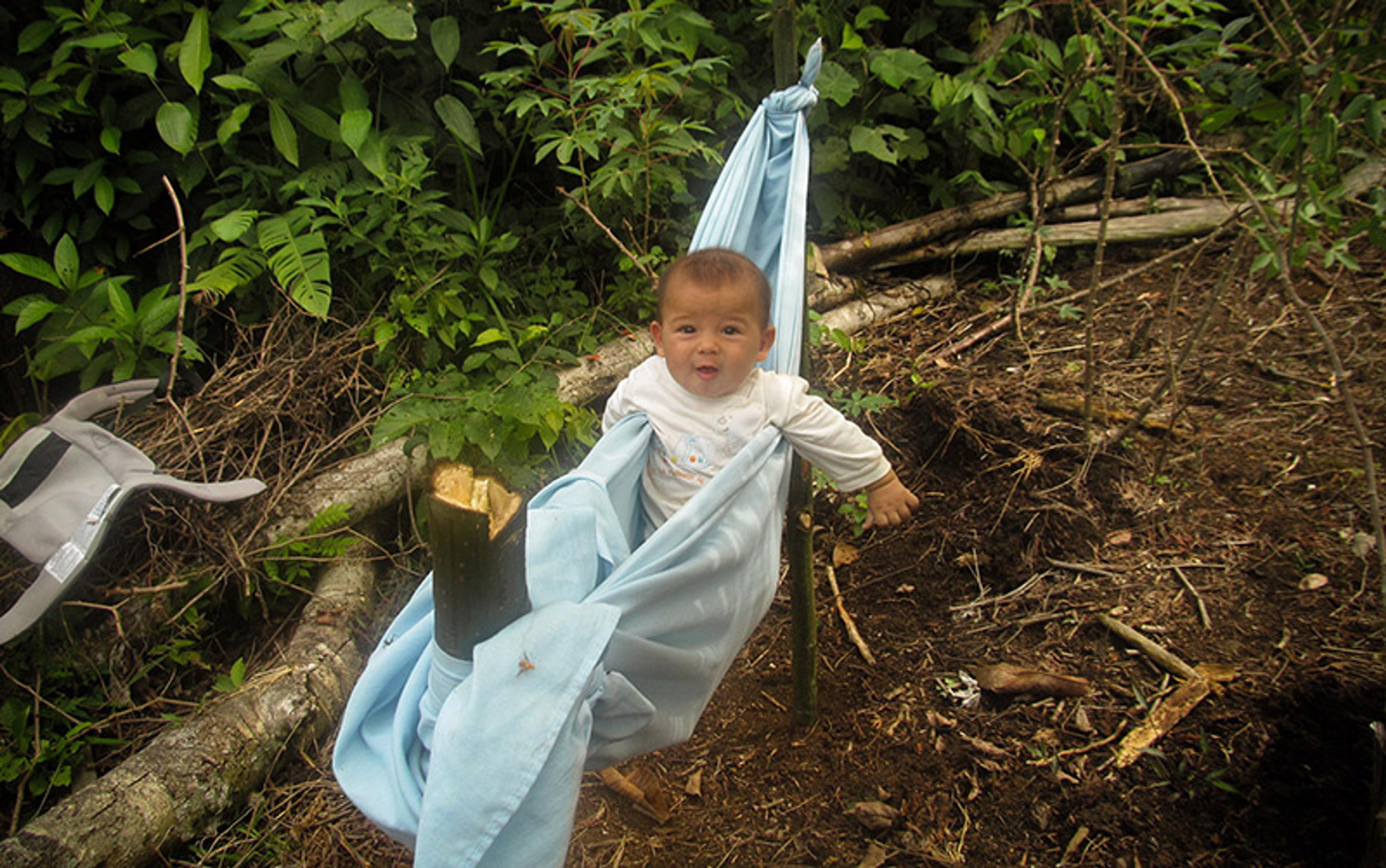
The relief of being able to breathe again: that’s perhaps a feeling familiar to most new parents. Like many other people I know, I also almost lost my mind after the birth of my first child. It’s hard to tell how the madness began: whether it started with the kind and persistent breastfeeding advice of the midwives at the baby-friendly hospital where I gave birth, or with a torn copy of Penelope Leach’s parenting bestseller, Your Baby and Child: From Birth to Age Five, first published in 1977, confidently handed to me by a friend who assured me it contained all I needed to know about childcare. Or maybe it was just in the air, everywhere around me, around us: the daunting feeling that the way I behaved – even my smallest, most mundane gestures – would have far-reaching consequences for my child’s future psychological wellbeing. I was certainly not the only parent to feel this way.
Contemporary parenting in postindustrial societies is characterised by the idea that early childhood experiences are key to successful cognitive and emotional development. The idea of parental influence is nothing new and, at a first glance, it seems rather banal: who wouldn’t agree, after all, that parents have some sort of influence over their children’s development? However, contemporary parenting (call it what you like: responsive parenting, natural parenting, attachment parenting) goes beyond this simple claim: it suggests that caretakers’ actions have an enormous, long-lasting influence on a child’s emotional and cognitive development. Everything you do – how much you talk to your children, how you feed them, the way you discipline them, even how you put them to bed – is said to have ramifications for their future wellbeing.
This sense of determinism feeds the idea of providing the child with a very specific type of care. As a document on childcare from the World Health Organization (WHO) puts it, parents are supposed to be attentive, proactive, positive and empathetic. Another WHO document lists specific behaviours to adopt: early physical contact between the baby and the mother, repeated eye contact, constant physical closeness, immediate responsiveness to infant’s crying, and more. As the child grows older, the practices change (think of parent-child play, stimulating language skills), yet the core idea remains the same: your child’s physical and emotional needs must be promptly and appropriately responded to, if she is to have an optimal development and a happy, successful life.
Like other such parents, in the first few postpartum months I also engaged, rather unreflectively, in this craze. However, when my son was four months old, during a period ridden with chaos, parental anxiety, sleep deprivation and mental fogginess, my husband and I made the decision to leave Europe. We packed our clothes and a few other things and hopped on a flight to Ecuador. Our final destination: a small Runa Indigenous village of about 500 people in the Ecuadorian Amazon. Our decision wasn’t as mad as it sounds. The Ecuadorian Amazon is where my husband grew up and where his family currently lives. It is also the place where I have been doing research for more than a decade. We wanted to introduce our newborn to our family and friends in the village, and we didn’t think twice before going. I could not yet imagine the repercussions this decision would have on me, both as a mother and as a scholar.
I ended up in frantic searches across the village to find my baby, under the perplexed stares of neighbours
In the first weeks of our stay in my husband’s village, family and neighbours quietly observed how I took care of my son. He was never out of my sight, I was there always for him, promptly responding to (and anticipating) any of his needs. If he wanted to be held or breastfed, I would interrupt any activity to care for him. If he cried in the hammock, I quickly ran to soothe his cries. Our closeness soon became the subject of humour, and then, as the months passed, of growing concern. Nobody ever said anything explicitly to me or my husband. Most Runa Indigenous people – the community to which my husband belongs – are deeply humble and profoundly dislike to tell others how to behave. Yet it became clear that my family and neighbours found my behaviour bizarre, if not at times utterly disconcerting. I did not really understand their surprise nor did I, in the beginning, give it too much thought.

People, however, started rebelling. They did so quietly, without making a fuss, but consistently enough for me to realise that something was going on. For instance, I would leave my baby with his dad to take a short bath in the river and, upon my return, my son would no longer be there. ‘Oh, the neighbour took him for a walk,’ my husband would nonchalantly say, lying in the hammock. Trying desperately not to immediately rush to the neighbours’ house, I would spend the following hours frenetically walking up and down in our yard, pacing and turning at any sudden noise in the hope that the neighbours had finally returned with my son. I was never able to wait patiently for their return, so I often ended up engaging in frantic searches across the village to find my baby, under the perplexed stares of other neighbours. I usually came back home emptyhanded, depressed and exhausted. ‘Stop chasing people! He will be fine,’ my husband would tell me affectionately, giving me the perfect pretext to transform my anxiety into anger for his fastidiously serene and irresponsible attitude. At the end, my son always came back perfectly healthy and cheerful. He was definitely OK. I was not.
On another occasion, a close friend of ours who was about to return to her house in the provincial capital (a good seven hours from our village) came to say goodbye. She took my son in her arms. She then told me: ‘Give him to me. I will bring him to my house, and you can have a bit of rest.’ Unsure whether she was serious or not, I simply giggled in response. She smiled and left the house with my son. I watched her walking away with him and I hesitated a few minutes. I did not want to look crazy: surely she was not taking away my five-month-old son? I begged my husband to go to fetch our baby just in case she really wanted to take him away. When we finally found them, she was already sitting in the canoe, holding my son in her lap. ‘Oh, you want him back?’ she asked me with a mischievous laugh. To this day I am not sure whether she would have really taken him or whether she was just teasing me.
As an anthropologist, I admit, I should have known better. Scholars who work on parenting and childrearing have consistently shown that, outside populations defined as WEIRD (white, educated, industrialised, rich and democratic), children are taken care of by multiple people, not solely their mothers. The dyad of the mother-child relationship upon which so much of psychological theory rests reflects a standard Western view of the family as a nuclear unit – where parents (and, more specifically, mothers) are in charge of most childcare. In most places in the world, relationships with grandparents, siblings and peers are as important as the ones with the parents. As a new mother, however, it was difficult to appreciate this reality, especially when people were not merely claiming my son as their own but also clearly showing to me that what they thought was important for a child’s proper development differed quite dramatically from my own beliefs.
This became clear one day when Leticia, my husband’s aunt, came to visit us. Leticia had in the past affectionately joked about how caring and loving I was toward my son, and how amazed she was at the time and attention I devoted to him. As we were sitting together in our thatched house, Leticia took my son in her arms and started playfully talking with him. She tenderly touched his nose and laughed. ‘Oh poor little baby,’ she exclaimed suddenly. ‘Poor little baby, what will you do if your mother dies?’ She kissed him on the cheek. ‘You will be an orphan! Alone and sad!’ she laughed cheerfully. She then turned around so that I was no longer in my son’s sight. ‘Look! There is no more mama! She is gone, dead! What will you do, my dear?’ She kissed him again and laughed softly.
In her landmark book on Inuit child socialisation, Inuit Morality Play (1998), the anthropologist Jean Briggs describes how Inuit adults ask children very similar questions. ‘Want to come to live with me?’ asks an unrelated woman to a toddler whose parents she is briefly visiting. Briggs argues that this kind of difficult teasing – which might sound inappropriate, even offensive to a Euro-American – helps young children think about matters of extreme emotional complexity, such as death, jealousy and loneliness. She describes at great length how, for the Inuit she worked with, this kind of teasing ‘cause[s] thought’. Likewise, I also often hear my family engaging in this kind of teasing with older children: this was, however, the first time I had become the target of it. For if Leticia’s teasing was intended to ‘cause thought’, my son was certainly not the only person she was encouraging to think.
To let children face the world re-orients their attention towards sociality, toward others
Hers was not just an admonishment on the perils of a too-exclusive attachment, a reminder of the eternal fluctuations of life and death. It was also an invitation for me, as a mother, to take a step back and let my son encounter and be held by others, lest he be ‘alone and sad’. In a place like a Runa village, where cooperation, work and mutual help are so important for living a good life, Leticia seemed to be telling me, my son truly needed to be with other people beyond his mother. Leticia’s episode made me think about Digna’s puzzlement at the way I carried my baby.
Despite the calm, respectful response Digna gave me at the time I was wrapping my son, she must have thought I was crazy. What could the concept of sensorial overstimulation have meant to her? Runa children are carried around in a sling with their faces toward the outside, all the time, everywhere, from dawn to night, under the rain and the sun, in the garden and in the forest, at parties that go on for hours where they fall asleep to the sounds of drums, cumbia music, and the excited yells of dancers. When Digna carried my son, she did so the way all Runa women do: either on her back, or on her hip. Digna made sure he could turn his face to the outside world. ‘This way he can see everything,’ she said to me.
I started from the assumption that my child needed to be protected from the world, his face safely turned toward his mother; she thought that a child needs to be turned toward other people, toward the world, because he belongs to it. Overstimulation, for Digna, was just the necessary work a baby has to do to become a participant in a thriving, exciting social life. To let children face the world re-orients their attention towards sociality, toward others.
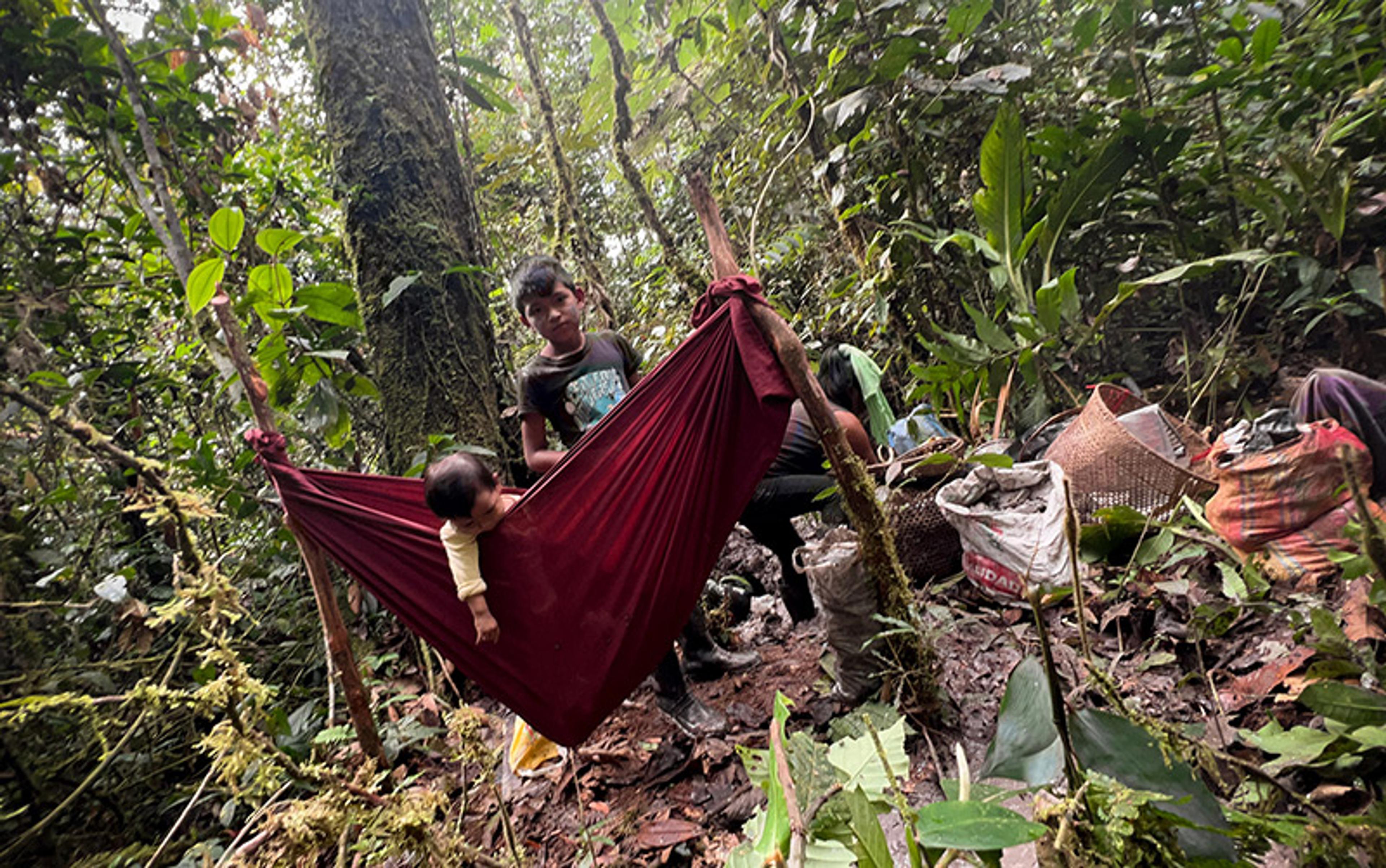
In one of their papers, the psychologists Barbara Rogoff, Rebeca Mejía-Arauz and Maricela Correa-Chávez beautifully describe how Mexican Mayan children pay more attention to their surroundings and to other people’s actions compared with Euro-American children. They explain the difference with the fact that Mayan children, unlike their Euro-American counterparts, are expected to actively take part in community life from early on. The practice of paying attention to social interactions, this encouragement to turn toward the community, seems to start, at least among the Runa, well before babies can speak or help at home. It starts, as Digna put it, by literally turning their faces toward the world.
If the idea of an exclusive, preponderant relationship between mother and son might have seemed alien to our Runa family, equally strange, if not plain wrong, was the idea that a child’s needs should be always and promptly met by her caretakers. This is another central idea of current parenting philosophies: children’s emotions, needs and desires should be not merely accommodated, but also promptly, consistently and appropriately responded to. This translates into a form of care that is highly child-centred, whereby children are treated as equal conversational partners, praised for their achievements, encouraged to express their desires and emotions, stimulated through pedagogical play and talk, often with considerable investment of time and resources.
These practices encourage the gentle cultivation of what the anthropologist Adrie Kusserow has defined as ‘soft individualism’, in which self-expression, psychological individualism and creativity are core values. It is not a coincidence that these are also qualities promoted in a neoliberal society where entrepreneurship, self-realisation and individual uniqueness are deemed paramount for success and happiness.
This approach is premised on the fantasy that there is a ‘natural’ way to raise humans
Taking this worldview up a notch, some people claim that findings from neuroscience support the goal of ‘optimal’ brain development as foundational to a child’s future success and happiness. The ideology is presented as if based on indisputable scientific evidence, but let us not be fooled. The approach fits perfectly with neoliberalism and has its origin in the culture of the US middle-upper class.
Proponents describe the intensive care that results from this pursuit as ‘natural’, drawing on idyllic and stereotyped accounts of childrearing in ‘traditional’ non-Western societies. There is a popular book I am often given as a gift by other parents whenever I mention that I work in the Amazon and am interested in children. It is The Continuum Concept: Looking for Happiness Lost (1975) by Jean Liedloff. The back cover of the German edition shows the author in the jungle: she stands, tall and blonde, in a shirt and a leopard-print bikini next to a bare-breasted Ye’kuana woman and her sleeping baby. The book – a bestseller in the so-called natural parenting movement – tells the story of Liedloff who, after living for two years with the Carib-speaking Ye’kuana of Venezuela, discovers the recipe for raising well-balanced, independent, happy children. This amazing result is accomplished, we are told, through practices such as co-sleeping, responsive care and natural birth.
Liedloff’s book, like the natural parenting movement, is based on the idea that people in industrialised Western countries have lost touch with the childrearing ways of our ancestors. Bringing together attachment theory, as well as a simplified theory of human evolution and cherrypicked information about childcare in non-Western societies, this approach is premised on the fantasy that there is a ‘natural’ way to raise humans. While responsive parenting and ‘natural’ parenting are not exactly the same, they can be thought of as two dots on a continuum: they both assume there is an optimal way to raise children that, if not followed, has negative consequences. The type of childrearing that both models encourage is also equally intensive and child-centred.
What these accounts, which claim roots in anthropology, fail to reflect is that, outside of postindustrial affluent societies, no matter how cherished, children are very rarely the centre of adults’ lives. For instance, Runa children, while affectionately cared for, are not the main focus of their parents’ attention. In fact, nothing is adjusted to suit a child’s needs. No canoe trip under a merciless sun is modified to meet the needs of a baby, let alone of an older child. No meal is organised around the needs of a young child. Parents do not play with their children and do not engage in dialogical, turn-taking conversations with them from an early age. They do not praise their children’s efforts, nor are they concerned with the expression of their most intimate needs. Adults certainly do not consider them as equal conversational partners. The world, in other words, does not revolve around children.
This is because children are not relegated to a child-only world nor deemed too fragile to engage in difficult tasks. From an early age, Runa children participate fully in adults’ lives, overhearing complex conversations between adults on difficult topics, helping with domestic tasks, taking care of their younger siblings. Participating in the adult world means that sometimes children can get frustrated, or denied what they want, or feel deeply dependent on others. At the same time, there is so much that they gain: they learn to pay close attention to interactions around them, to develop independence and self-reliance, and to forge relationships with their peers. Most importantly, in this adult world, they are constantly reminded that other people – their parents, their family members, their neighbours, their siblings and peers – also have desires and intentions.
The psychologist Heidi Keller and colleagues wrote that good parenting for many societies is primarily about encouraging children to consider the needs and wants of others. The Runa are no exception. They enormously value qualities such as social responsiveness and generosity – capacities deemed indispensable for living a good life in a closely knit community. These presuppose the ability to acknowledge and respond to other people’s desires and needs. Runa childrearing practices reflect these priorities. The very idea that children’s needs and desires should be always and promptly met by caretakers is completely foreign to the Runa. Instead, not answering to some of these needs and desires might be a valuable practice.
The goal here is to transform a child into someone who recognises that her own will is just one among many
This is evident in an episode that occurred shortly after we arrived in Ecuador. I was then zealously following the breastfeeding instructions I received from the midwives (exclusive and on demand! In a quiet place and without interruptions! As recommended by the WHO! And the baby-friendly hospital initiative!) I was baffled when one day, right in the middle of breastfeeding, our neighbour, Luisa who was sitting next to me, placed her hand on my breast and took the nipple away from my son. He looked at me surprised. He grunted loudly. Luisa laughed. ‘Do you want your milk, little baby? Do you really want it?’ She kept my breast away from him. I watched her teasing him, trying to escape from her without looking rude or excessively defensive. ‘Your poor mama!’ she continued without paying attention to me: ‘Just leave her alone! This is not yours!’ My son became purple with rage and twisted in my arms. Luisa laughed again, removed her hand and kissed his little hand. I did not know how to react: my feelings ranged between confusion and anger. I asked my husband why she would do such a thing. He stared at me blankly. ‘To tease the baby! To let him know that the breast is not really his,’ he answered matter of factly.
Why did Luisa make my son purposefully uncomfortable? What was her goal? The more I reflected on this, the more I began to see the teasing as crystallising a central moral lesson: in stating ‘this breast doesn’t belong to you, it is your mother’s’, Luisa redirected my son’s attention to the presence and desires of others. The intentional, playful refusal to attend to a baby’s desire for milk invites him (and anyone else present) to acknowledge that he is not the only one who has a will and desires in an interaction. It is exactly by these acts of playful refusal, by not promptly responding to their children’s will, by not making them the centre of their world, that the Runa cultivate in their children an awareness of other people’s needs and of their own place within a dense web of relationships. The childrearing goal here is to transform a child into someone who recognises and acknowledges that her own will is just one among many.
Unlike what parenting books might tell us, there is simply no single recipe for good parenting. This is because each act of parenting is always and inescapably an ethnotheory of parenting: a set of practices that aim to shape a good person in a given society. Of course, one doesn’t need to travel to all the way to the Amazon to realise that. Step out of the privileged space of what Barbara Ehrenreich and John Ehrenreich in 1979 called ‘the professional-managerial class’, and the kind of debates surrounding childcare are likely to be very different. However, because this is a parenting ideology produced by a cultural and political elite that has a tremendous power in the world, it has quickly become normalised.
What is most worrying is to see this ideology being increasingly exported, under the guise of evidence-based early childhood interventions, to the Global South. Promoted by organisations such as the WHO, the World Bank and UNICEF, such interventions aim to teach low-income families in the Global South to become responsive carers and optimise their children’s cognitive and emotional development through the adoption of ‘appropriate’ behaviour. These programmes assume optimal childcare to be a universal, objective, neutral fact that can be easily translated into a plethora of handy practices. This model of childrearing (and its more extreme neuroscientific version, where every act is seen as enhancing or hurting the brain) is anything but apolitical and acultural. Instead, it finds its origin in a specific culture and socioeconomic context where everything (including children’s abilities) can be measured and optimised in terms of future life success.
To assume one cultural model of childcare is universally applicable to children everywhere, as WHO and others do, is dangerous. Not only do such programmes encourage culturally specific childrearing with little scientific basis, they also depict any type of care that deviates from the norm as in need of correction. Like early missionaries who travelled around the world teaching the natives how to be ‘good’, such interventions assume that parents in the Global South need to be taught how to raise their children properly.
Following current orthodoxy, Runa childrearing – with its casual breastfeeding, abrupt weaning, no extensive parent-child play, no lengthy adult-child talk – would be described as ‘lacking’ in so many respects. And yet, my Runa friends and family thought my own childcare practices were conspicuously inadequate to raise a child in the context of their community life. Their observations, their puzzlement and their quiet defiance of my own childcare practices remind us that, whenever we talk about childrearing, we are not talking about achieving some objective child development based on irrefutable scientific evidence, but rather about a moral project: a moral project about what kind of people we would like our children to become, what society we would like to live in, and what kind of economy we would like to serve. As my Runa friends and family have subtly but relentlessly demonstrated, there is more than one way to flourish as humans in this world.

